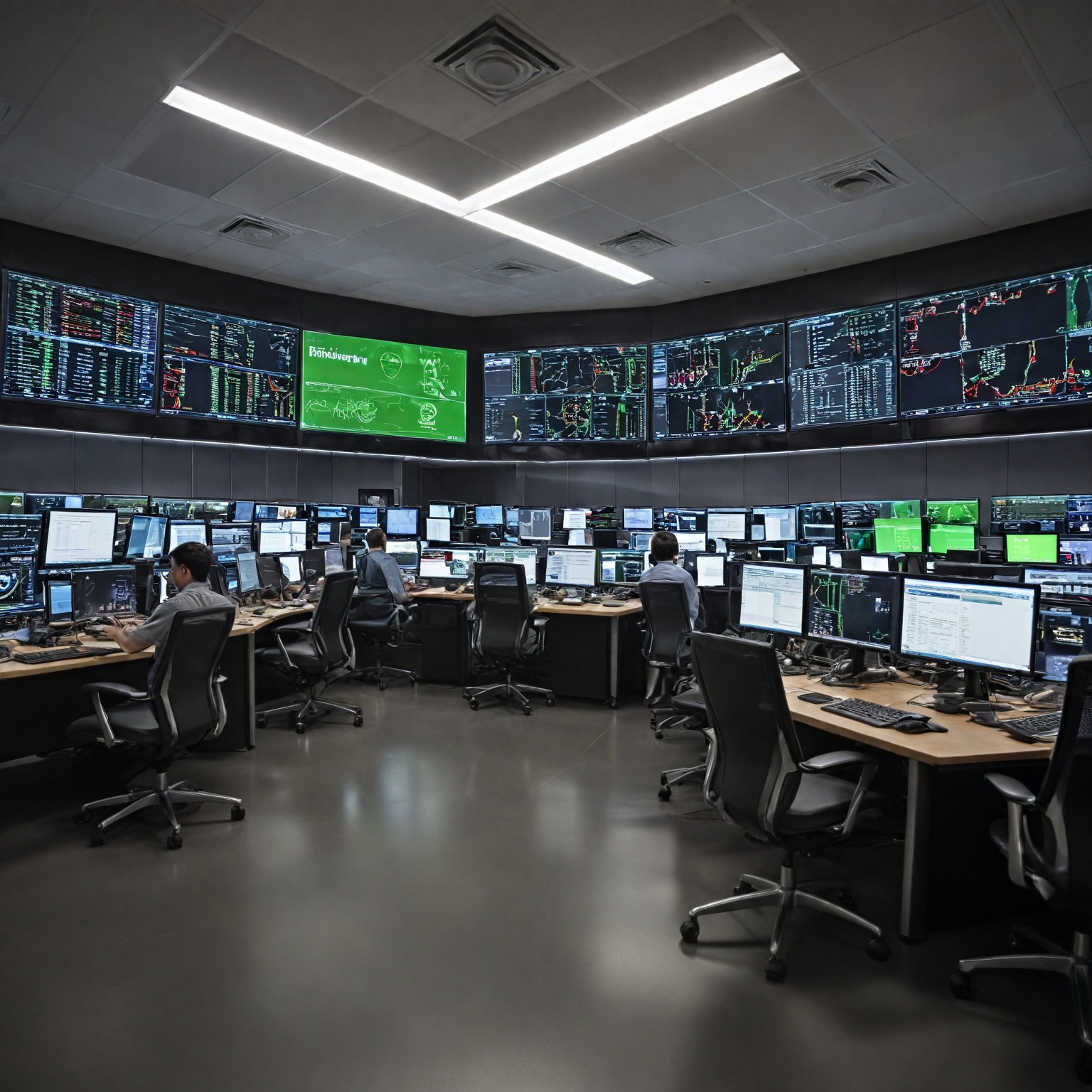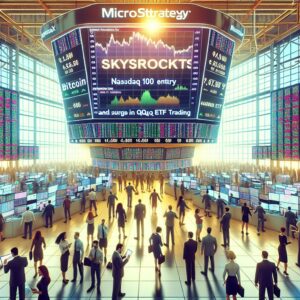Summary
Nvidia Corporation, a globally recognized developer and manufacturer of graphics processing units (GPUs) and related multimedia software, plays a pivotal role in the semiconductor industry. This technological powerhouse operates across various specialized markets, notably including GeForce for gamers, Quadro for designers, Tesla and DGX for AI data scientists and big data researchers, and has established a dominant presence in the financial services sector. With its advanced technologies and rapid pace of innovation, Nvidia’s products are widely used in financial trading to model future trends, analyze market conditions, and forecast potential outcomes. The company also maintains a significant presence in the trading ecosystem, particularly through exchange-traded funds (ETFs) that hold a substantial proportion of Nvidia shares. Despite its market leadership, Nvidia is anticipated to face new challenges, primarily due to rising competition, complex market dynamics, and the increasing intricacy of analytics in financial institutions. As the high stakes of financial trading demand more speed and accuracy in data analysis, Nvidia is set to navigate these evolving requirements.
Overview
Nvidia Corporation, a leading developer and manufacturer of graphics processing units (GPUs) and related multimedia software, plays a significant role in the global semiconductor industry. It operates through several specialized market segments, including GeForce for gamers, Quadro for designers, and Tesla and DGX for AI data scientists and big data researchers, among others.
Nvidia’s success is attributed to a multitude of factors, including rapid technological innovation, experienced workforce, and strategic market positioning that has helped it become a key player in the sector. In the high-speed world of financial trading, Nvidia’s products are leveraged to model future trends, analyze market conditions, and forecast potential outcomes. The company’s advanced technologies have transformed the financial services industry, with a continuous stream of data driving decision-making and impacting bottom lines.
Moreover, Nvidia has a significant presence in the investment and trading ecosystems. It is involved in a vast trading network in the realm of exchange-traded funds (ETFs), with ETFs holding more than four billion shares of Nvidia, equating to around 17% of the total outstanding shares. The firm’s strong return potential is evaluated through comprehensive analyses and quantifiable stock market data, such as stock prices, historical returns, and trading volumes.
However, despite Nvidia’s market leadership and successful track record, the company faces impending challenges in the form of rising competition and complex market dynamics. Advances in machine learning and AI, along with sophisticated quantitative methods, have made analytics in investment banks, insurers, asset managers, and hedge funds increasingly intricate. Additionally, the high stakes of financial trading, where milliseconds can mean millions of dollars, impose demands on the speed and accuracy of data analysis.
Historical Context
Nvidia provides guidance on selecting the right hardware, like GPUs, for tackling specific development challenges, alongside additional support in the form of training and events. It has established a software advantage that creates “vendor lock-in”, even in the face of rising competition. As a result, Nvidia has carved out a significant niche in the Semiconductors & Semiconductor Equipment industry.
Nvidia is also committed to environmental sustainability. Its innovations in AI and accelerated computing are setting new standards for environmental responsibility while powering a more sustainable future. It requires suppliers to report their participation in environmental initiatives quarterly and uses reverse logistics solutions to streamline product returns, eliminate international shipments, and reduce the company’s carbon footprint. All Nvidia employees receive training in conduct, ethics, and sexual harassment to ensure a positive and ethical work environment.
The Role of Artificial Intelligence and Machine Learning
Artificial intelligence (AI) and machine learning (ML) are pivotal tools in Nvidia’s business model and have a significant influence on the trading ecosystem that has developed around the company. One of the main benefits of these technologies is the ability to enhance model accuracy, which has a direct impact on the organization’s bottom line through the optimization of machine learning pipelines. Nvidia leverages accelerated compute for tasks ranging from machine learning to deep learning without necessitating the learning of new tools. This innovative approach has significantly lowered the barrier to entry through interoperability and integrations with leading data science frameworks like Apache Spark, cuPY, Dask, XGBoost, and Numba. Notably, the company also collaborates with several deep learning frameworks such as PyTorch, TensorFlow, and Apache MxNet, broadening adoption and encouraging further integration across the data science ecosystem.
Nvidia’s strategic market approaches also rely heavily on AI and ML. The company strategically adjusts its GPU prices based on regional purchasing power, partnering with local retailers in high import duty markets, such as Brazil and India, to offer regional discounts and special festival promotions.
However, despite the benefits and growth the AI and ML sectors have brought Nvidia, there are emerging challenges. The generative AI market is anticipated to continue expanding, but the introduction of more rules and regulations could affect Nvidia’s AI chips. Moreover, U.S. trade restrictions on China’s advanced semiconductors are having an impact on Nvidia’s growth, considering Chinese sales formed a significant part of Nvidia’s data center sales.
Nvidia’s Market Position and Strategy
Nvidia has established a strong position in the market, marked by its remarkable performance and rapid growth. However, the company also faces challenges and potential threats to its market share. There are concerns about other chipmakers producing more affordable products, which could influence Nvidia’s earnings or prompt it to decrease prices, thus impacting profit margins.
Despite these concerns, Nvidia’s growth and future potential have been recognized by market analysts. The company’s stock has been given a “buy” rating, affirming its successful transition and market share gains. Moreover, the company is acknowledged for its strategic approach to navigating the complex landscape of the technology sector. Nvidia’s strategy involves studying the market for emerging opportunities, understanding competitors’ strategic decisions, and building a coherent strategy for sustainable competitive advantage.
Nvidia’s Competitive Analysis
A crucial aspect of Nvidia’s strategy is its competitive analysis, which involves thorough research and evaluation of its competitive landscape. This analysis enables Nvidia to understand its strengths, weaknesses, opportunities, and threats (SWOT) in relation to its competitors. Comparisons across multiple fundamental and technical indicators are used to measure Nvidia against its competition.
Nvidia’s Global Strategy
Apart from understanding its competition, Nvidia is also implementing an ambitious global strategy to consolidate its leadership position and expand its reach. This strategy involves several key components, such as navigating geopolitical complexities, fostering AI development in emerging markets, and creating a comprehensive software ecosystem that complements their industry-leading hardware.
To sum up, Nvidia’s market position is strong, but it is also under threat from various quarters. It’s important for investors to keep a close watch on the company’s strategies and the changing market conditions to make informed investment decisions.
Sustainability and Corporate Social Responsibility Initiatives
NVIDIA takes significant steps towards sustainability and corporate social responsibility. To ensure that the company reaches its sustainability targets, NVIDIA performs annual assessments of its corporate responsibility impacts. These assessments entail a comprehensive analysis of NVIDIA’s social and environmental effects. NVIDIA accomplishes this by gauging stakeholder expectations, evaluating market trends, and identifying potential risks.
NVIDIA’s sustainability and corporate social responsibility initiatives are formulated within frameworks such as the Global Reporting Initiative (GRI), the Sustainability Accounting Standards Board (SASB), the Task Force for Climate-Related Financial Disclosures (TCFD), and the United Nations Sustainable Development Goals (UN SDG). These frameworks play a pivotal role in guiding NVIDIA’s sustainable contributions and setting business priorities.
A crucial part of NVIDIA’s corporate social responsibility is to encourage and empower employees to make a positive impact on the world. NVIDIA strives to foster an environment where its employees can do their life’s work and contribute to creating a more sustainable future.
The company’s efforts towards sustainability and corporate social responsibility are reflected in their annual report, which includes goals related to renewable energy, Leadership in Energy and Environmental Design (LEED), ISO certification, and diverting waste from landfill. This report also details NVIDIA’s completion of the assessment on Scope 3 emissions. Although the report is transparent in presenting the company’s sustainability efforts such as energy-efficient products, inclusiveness, diversity, and supply chain management, it does not provide specific goals and quantitative data for analysts to measure progress.
In the area of high-performance data science, NVIDIA has provided the foundation for a new ecosystem with RAPIDS. RAPIDS lowers the barrier of entry for high-performance data science, thus contributing to NVIDIA’s sustainability initiatives.
Key Market Influencers
High-Frequency Trading
High-frequency trading (HFT) is considered a critical element in the financial market. Regulators suggest that the practices of HFT contributed to market volatility such as the Flash Crash of May 6, 2010, citing less stringent risk controls for faster trades. On the other hand, members of the financial industry believe that high-frequency trading substantially improves market liquidity, narrows bid–offer spread, lowers volatility, and makes trading and investing cheaper for other market participants. However, it remains an open question whether algorithmic trading and algorithmic liquidity supply are equally beneficial in more turbulent or declining markets.
NVIDIA’s Dominance in AI Market
NVIDIA has experienced a surge in demand for its accelerated computing and generative AI solutions worldwide, across companies, industries, and nations, as reported by Jensen Huang, the CEO of NVIDIA. However, the growth of the generative AI market has been accompanied by increased regulations that could affect NVIDIA’s AI chips. The U.S. trade restrictions on China’s advanced semiconductors, which were a significant part of NVIDIA’s data center sales, are also impacting NVIDIA’s growth.
Acquisition of Mellanox
NVIDIA’s acquisition of Mellanox triggered concerns due to its potential to solidify NVIDIA’s dominance in the AI industry, which is expected to add $15 trillion to the global economy by 2030. This move drew scrutiny from antitrust authorities in the European Union and the United States.
NVIDIA’s Trading Ecosystem
NVIDIA’s strong market sentiment, reflected by its high price-to-book (PB) and price-to-sales (PS) ratios, has resulted in the creation of a short-term trading ecosystem. In addition, the low price-to-earnings (PE) ratio indicates potential undervaluation of NVIDIA’s stock. This ecosystem attracts considerable trading interest, with NVIDIA being one of the most actively traded single-stock options in the market.
Software Ecosystem
A significant aspect of NVIDIA’s strategy is its comprehensive software ecosystem. This ecosystem, exemplified by offerings such as LaunchPad, lowers the barrier to entry for AI development and integrates seamlessly with NVIDIA’s hardware. This combination creates a unified development environment that is advantageous for NVIDIA’s global strategy and simplifies adoption for developers worldwide. Despite competitive offerings, such as DeepSeek, the software ecosystem of NVIDIA remains a significant moat, making it challenging for the industry to shift away from its technology on a large scale.
Potential Challenges and Impact on Trading Ecosystem
The trading ecosystem around Nvidia faces several potential challenges due to market and regulatory dynamics. The fragmentation of the market, which has favored HFT, coupled with the deregulation trend that began in 2005 with the Regulation National Market System (Reg NMS) passed by the SEC, has changed the landscape of stock exchange . These changes have given an edge to traders with faster technologies, enabling them to alter the prices of securities they trade . However, regulators and industry members have expressed concerns over the volatility these practices can bring, as evidenced in the May 6, 2010, Flash Crash .
Despite these concerns, there are claims that high-frequency trading improves market liquidity, narrows the bid-offer spread, and lowers volatility, thus making trading cheaper for other market participants . However, its impact on smaller-cap stocks and its efficacy in more turbulent markets remain uncertain .
The Nvidia-centric trading ecosystem operates in an extremely competitive market, where performance, product offerings, access to customers, partners, distribution channels, software support, compliance with industry-standard APIs, manufacturing strengths, processor pricing, and total costs are critical determinants of success . As such, Nvidia must constantly evaluate market trends, competitors’ strategic decisions, stakeholder expectations, and potential risks to maintain a sustainable competitive advantage and meet its sustainability targets .
Collaboration with Regulators and Industry Participants
As part of their strategic approach, Nvidia has established a commitment to collaborate with regulators and other industry participants. This approach is not only intended to challenge industry norms, but to also cultivate a distinct, valuable position in the market. This includes recognizing and responding to changes in the market and regulatory landscape, which has seen an increasing fragmentation and complexity.
Furthermore, Nvidia has demonstrated an active role in promoting environmental responsibility, requiring their suppliers to report quarterly on their involvement in environmental initiatives and using reverse logistics solutions to reduce international shipments.
In terms of industry participation, Nvidia’s dominance is rooted in strategic investments that have been made over several decades. These include significant resources dedicated to the CUDA ecosystem, developer education, and community-building around AI.
Future Implications and Predictions
Future forecasts of Nvidia’s trading figures indicate varying outcomes. The NASDAQ predicts Nvidia’s 2025 PE prediction to be $2.77, which could translate to 35X equals $97, 40X equals $110.80, and 50X equals $138.50. By 2026, the PE prediction increases to $3.98. However, the accuracy of these predictions is questionable. As one trader points out, an AI predicted that NVDA would rise to 320 “in the near future” in June 2024, but this prediction didn’t take into account the data from the chart.
However, Nvidia is likely to face challenges in the future. The generative AI market is projected to grow, but the introduction of more rules and regulations could affect Nvidia’s AI chips. U.S. trade restrictions on China’s advanced semiconductors are already impacting Nvidia’s growth, with Chinese sales constituting a significant portion of Nvidia’s data center sales. Concerns have also been raised about Nvidia’s near-monopoly in the AI industry, following its acquisition of Mellanox. This monopoly has sparked scrutiny from antitrust authorities in the United States and the European Union, as the AI market is anticipated to add $15 trillion to the global economy by 2030.
The content is provided by Sierra Knightley, Financial Pulse Now


























